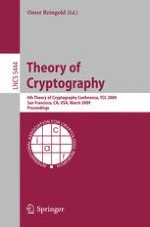TCC 2009, the 6th Theory of Cryptography Conference, was held in San Fr- cisco, CA, USA, March 15–17, 2009. TCC 2009 was sponsored by the Inter- tional Association for Cryptologic Research (IACR) and was organized in - operation with the Applied Crypto Group at Stanford University. The General Chair of the conference was Dan Boneh. The conference received 109 submissions, of which the Program Comm- tee selected 33 for presentation at the conference. These proceedings consist of revised versions of those 33 papers. The revisions were not reviewed, and the authors bear full responsibility for the contents of their papers. The conference program also included two invited talks: “The Di?erential Privacy Frontier,” given by Cynthia Dwork and “Some Recent Progress in Lattice-Based Crypt- raphy,” given by Chris Peikert. I thank the Steering Committee of TCC for entrusting me with the resp- sibility for the TCC 2009 program. I thank the authors of submitted papers for their contributions. The general impression of the Program Committee is that the submissions were of very high quality, and there were many more papers we wanted to accept than we could. The review process was therefore very - warding but the selection was very delicate and challenging. I am grateful for the dedication, thoroughness,and expertise ofthe ProgramCommittee. Obse- ing the way the members of the committee operated makes me as con?dent as possible of the outcome of our selection process.
